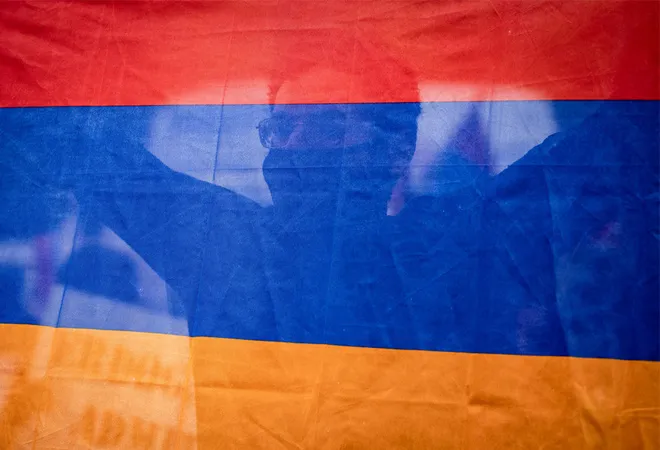
Besides the powerful impact on the global healthcare systems, the COVID-19 pandemic is also the reason of serious political and socio-economic problems in many countries, including Armenia. Even before the COVID-19 pandemic hit the country, acting Prime Minister Nikol Pashinyan had an intense political struggle with representatives of former political elites who lost power as a result of the 2018 Velvet Revolution. While the chances of the ousted elite making a return to power were minimal, the COVID-19-induced socio-economic crisis has created a more conducive situation.
The peculiarities of the South Caucasus region—the unresolved Nagorno-Karabakh conflict, socio-economic and domestic political problems as a result to COVID-19—may cause a serious situation that will require the participation of regional and global actors. For instance,
military clashes on the internationally recognised Armenia-Azerbaijan border between 12-16 July 2020.
Armenian authorities and local experts think that Azerbaijani authorities were pushed to ignite these clashes to shift the public attention from the difficult internal situation caused by COVID-19.
It is also important to underline the unprecedented activity that was shown by Turkey during the July clashes. Turkey, usually an active supporter of Azerbaijan, openly declared its readiness to engage in the conflict on the Azerbaijani side. It was only because of the strict position of Russia, a long-term military and political ally of Armenia, that Turkey changed its mind. During conversations with their Turkish counterparts, Russian President Vladimir Putin and foreign minister Sergei Lavrov both
openly said that Turkey’s position is the matter of great concern. Additionally, Russia also carried out sudden military exercises close to the Turkey border.
As of 7 September,
Armenia has reported 44,845 COVID-19 cases registered, with 40,121 recoveries, 3549 active cases, 900 deaths. The number of daily cases and the pressure on the local healthcare system have eased in recent weeks, but in May and June the situation was so dire that Armenian authorities said the healthcare system was near collapse. Local authorities acknowledged that people died at home due to the lack of hospital beds, and
Pashinyan even said, “We have reached a critical stage and are passing through hell”.
The Armenian authorities blame the citizens for their irresponsibility and causing such a high number of COVID-19 cases in the country. But despite the serious pressure on the healthcare system, the Armenian authorities have refused to bring back lockdown restrictions such as stay-at-home policies and a closure of offices and businesses due to the pressures on the economy.
The pandemic has had an
impact on the Armenian economy, including a 5.7 percent decline in the population’s general activity rate in January-July 2020 (as compared to the same period in 2019). Although the population’s general activity rate in July 2020 was 9.7 percent higher than in June, it was still 10.2 percent lower than that in July 2019. Additionally, Armenia saw a dramatic decline of 11.3 percent in foreign trade in January-July 2020, as compared to the same period of 2019. Armenia’s exports in January-July declined by 6.4 percent and import declined by 13.7 percent.
At the end of 2019, Armenia was a leader in the Eurasian Economic Union with an annual GDP rise of 7.6 percent. The Armenian government expected a 4.9 percent rise in the state budget in 2020, with international organisations putting this figure higher (for instance, the World Bank predicted a 5.1 percent rise in the country’s state budget).
Now, in the post-COVID-19 scenario, the Armenian government
expects a 5 percent fall in the state budget by the end of 2020, while the Armenian Central Bank
expects a 4 percent fall. An economy recovery is predicted only in 2021, with a 7.2 percent rise.
Restrictions imposed during COVID-19 and Russia’s economic problems have hit Armenian exports as well as remittances from seasonal Armenian workers in Russia. Tens of thousands of these workers have lost their jobs, with Armenia recording a 30.5 percent decline in remittances.
The finance ministry
predicts that by the end of 2020 the state budget will be 324 billion dram (US$673.5 mn) short instead of the pre-COVID-19 projection of 160.7 million dram budget shortage. The Armenian government is now planning to seek a US$540 million loan, with the IMF already approving a US$315 million grant. The government plans to make up the rest of the budget shortage by issuing domestic bonds and getting loans from other international financial institutions. At the end of 2019, Armenia’s total public debt reached US$7.324 billion, and these loans will only add to the debt pressure.
COVID-19 has also caused some socio-economic churn in the country, which will likely lead to the decline in the popularity of the authorities and a rise in protests. Despite the lockdown and emergency measures, protests have already broken out across the capital Yerevan.
Despite the tense economic situation, the government does not have many options. It does not have enough recourse to cover all the losses incurred by businesses, even though
Pashinyan said in March that the government was planning to spend US$310 million for recovery. The government’s measures to fight COVID-19 have proved ineffective, and the country is now the
regional leader in the number of cases per 1 million people (15,128). This puts the government’s economic recovery plan in doubt.
The political opposition will attempt to capitalise on this situation, using the media to encourage the disgruntled citizenry to protest.
Given the situation, the Armenian government must effectively spend its limited resources—and seek additional resources—to finance anti-crisis measures. The political future of Pashiyan and other authorities depends on the post-pandemic economy recovery.
The views expressed above belong to the author(s). ORF research and analyses now available on Telegram! Click here to access our curated content — blogs, longforms and interviews.



 Besides the powerful impact on the global healthcare systems, the COVID-19 pandemic is also the reason of serious political and socio-economic problems in many countries, including Armenia. Even before the COVID-19 pandemic hit the country, acting Prime Minister Nikol Pashinyan had an intense political struggle with representatives of former political elites who lost power as a result of the 2018 Velvet Revolution. While the chances of the ousted elite making a return to power were minimal, the COVID-19-induced socio-economic crisis has created a more conducive situation.
The peculiarities of the South Caucasus region—the unresolved Nagorno-Karabakh conflict, socio-economic and domestic political problems as a result to COVID-19—may cause a serious situation that will require the participation of regional and global actors. For instance,
Besides the powerful impact on the global healthcare systems, the COVID-19 pandemic is also the reason of serious political and socio-economic problems in many countries, including Armenia. Even before the COVID-19 pandemic hit the country, acting Prime Minister Nikol Pashinyan had an intense political struggle with representatives of former political elites who lost power as a result of the 2018 Velvet Revolution. While the chances of the ousted elite making a return to power were minimal, the COVID-19-induced socio-economic crisis has created a more conducive situation.
The peculiarities of the South Caucasus region—the unresolved Nagorno-Karabakh conflict, socio-economic and domestic political problems as a result to COVID-19—may cause a serious situation that will require the participation of regional and global actors. For instance,  PREV
PREV


